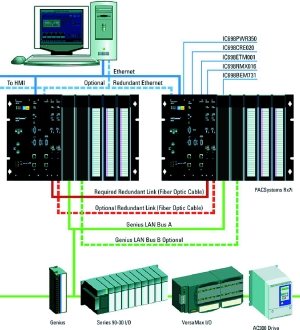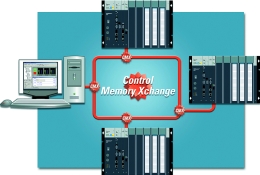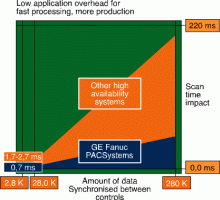
For many years, programmable logic controllers (PLCs) have provided OEMs and end-users with a highly reliable method of control. However, engineers working with PLCs have to plan for generational upgrades to achieve greater functionality and improve their control system's ability to communicate beyond the plant floor.
Now, a new type of control system, called programmable automation controllers (PACs), offers significantly more flexibility, openness and performance. PACs allow users to make a leap in capability without re-engineering. Featuring a portable control engine that sits on top of the operating system, PACs also give users the ability to firstly maximise the benefits of their application; and secondly, to optimise the automation platform.
The innovative PACSystems family from GE Industrial, GE Fanuc Automation, which addresses the industry-wide need for a PAC platform, is the controller environment that provides a leap in performance without the historical burden of migration path and conversion. PACSystems features a single control engine and universal programming environment; as well as portability across multiple hardware platforms to deliver a true convergence of control choices.

The need for PACs
PLCs have been the control solution of choice for more than two decades, delivering the speed and reliability necessary in industrial applications, rugged design for demanding plant environments and proven performance. While not issues in the past, these controllers are built on proprietary architectures, and are designed for programming and implementation in a specific application. Communication beyond the plant levels of the enterprise - the device, control and supervisory tiers - can often require a generational upgrade.
In recent years, however, many organisations have sought to integrate disparate plant floor equipment and networking systems, and to connect them to operations and enterprise-level systems and processes. Traditional control solutions do not allow the level of openness and flexibility required to deliver desired benefits often because numerous platforms and systems must be deployed to automate the entire enterprise. Enabling interoperability and information exchange among these pieces of equipment and systems can be a challenge, if not impossible in some cases.
In this new model, traditional control systems have the following limitations:
* Control system implementation may not be fast or easy due to multiple platforms from different vendors, all requiring different programming for discrete, process and motion logic.
* While recognising the value of implementing the latest automation control technologies, users may be hesitant to adopt these technologies and products for fear that they will become obsolete.
* The time and expense to re-engineer an existing system might not be offset by the benefits of the upgraded system's capabilities.
* Current automation systems can often have difficulty keeping pace with the need to accommodate ever-increasing quantities of data.
* The quantity of development, user and engineering tools and platforms can be overwhelming, leading to extensive delays in specifying and implementing automation systems, and incurring steep training costs.
* Once it is finally up and running, a specific control system may perform well in one application; however, successfully adapting it to another one can often prove difficult.
Given these limitations, the functionality of PLCs has been expanding during recent years to provide greater application flexibility and interoperability. However, most PLC manufacturers have not adequately defined and positioned their controllers in this evolutionary role or sought to extend the functionality of these proven industry workhorses to transform them into more revolutionary solutions - until now.
Defining PACs
Powered by a single, portable control engine and using a single development tool for multiple applications, PACs enable true control convergence and integration of plant floor operations with business systems, rather than a mere, less-than-seamless connection of disparate parts and pieces.
PACs are defined by the following features and capabilities:
* Multidomain functionality - including logic, motion, HMI and process control - on a single platform.
* A common development platform for the design and integration of multidomain automated systems.
* Allowing OEMs and end-users to deploy multiple control applications on a single platform.
* Facilitating open, modular control architectures that enable highly distributed automated plant environments.
* Employing de facto standards for network interfaces, languages, etc, to allow data exchange as part of networked multivendor systems.
While a PAC's form factor can be similar to that of a traditional PLC, a PAC's capabilities are far more comprehensive. PACs are multifunctional controller platforms that encompass various technologies and products that users can mix, match and implement at will. PLCs, on the other hand, are products grounded in proprietary architectures that are equipped with the capabilities that the manufacturer deems necessary.
The primary differentiator between the two is the foundation upon which each is based. Whereas a PLC's capabilities are grounded in specific hardware and cannot be moved easily from PLC to PLC, a PAC's functionality is rooted in its portable control engine. Each application interfaces with this engine, which sits on top of the user's operating system of choice, with few changes required to move applications from system to system. Since the engine is separate from the hardware and uses a common operating system, the platform can grow and change as rapidly as user needs demand.
From an application standpoint, while traditional PLCs are strong in discrete control but can be weaker in other areas, users can develop and implement discrete, process and motion control applications from the PAC's single platform with equal agility and reliability.
While PLCs are built on proprietary technologies, PACs make extensive use of COTS (commercial off the shelf) products and technologies, which:
* Help ensure reliability and availability of systems because hardware and software can be maintained quickly and easily.
* Reduce system price and downtime because they are readily available off the shelf.
* Increase openness, flexibility and scalability.
Benefits of PACs
A PAC control solution, such as GE Fanuc Automation's PACSystems, delivers the benefits that both plants and OEMs need, including:
* Increasing productivity and operational efficiency - a single portable control engine and universal engineering development environment allows rapid development, implementation and migration, and, through its openness and flexibility, enables true control convergence and seamless integration with operations and enterprise-level business systems to streamline plant processes.
* Reducing operational costs by:
- employing common, standards-based architectures and networks.
- enabling engineers to choose different system components for a platform that uses cost-effective COTS rather than proprietary products and technologies.
- requiring user-training on only one platform and development environment, rather than several.
- providing a seamless migration path that protects investments in both I/O and applications development.
* Giving users more control over their control system - PACSystems provides users with the flexibility to choose the hardware and programming language that best suits each particular application, design upgrades on their own timetables, and design and build products at any location.
The PACSystems Solution
The new GE Fanuc Automation's PACSystems family features a control engine that is built on standard embedded architecture with commercial deterministic operating systems, making the engine portable to multiple platforms and allowing users to choose the hardware and programming language that best suits each particular application. The system supports distributed I/O through such standards-based communications as Ethernet, Profibus, DeviceNet and Genius networks.
PACSystems is driven by GE Fanuc Automation's Proficy development software, which provides a universal engineering development environment for programming, configuration and diagnostics. Users can develop a control program with the easy-to-use Windows-based software and apply it to the system of their choice.
With tag-based programming, a library of re-usable code and a test edit mode for improved online troubleshooting, Proficy Logic Developer is a user-friendly environment that can increase design flexibility and improve engineering efficiency and productivity.
Control Memory Xchange shares control data up to 200 times faster than Ethernet
Developed with GE Fanuc Automation's latest technology, PACSystems Control Memory Xchange allows multiple devices to share large amounts of control data over a fibre-optic deterministic network at speeds up to 200 times faster than Ethernet. Increasing automation performance and reliability, this high-speed memory - sharing application operates in parallel to the main logic CPU with virtually no effect on the scan time of the control processor.

High-speed memory sharing benefits
Applications that benefit from PACSystems Control Memory Xchange include any process requiring high speed, high volume data acquisition for high-resolution measurement and fast response.
Additionally, PACSystems Control Memory Xchange allows users to capture process and regulatory compliance data at tighter frequencies, which can help companies more precisely measure process performance. With greater bandwidth and capacity, users can also acquire a higher number of parameters for future process analysis. Manufacturers can augment data management systems, such as Proficy Historian software from GE Fanuc Automation, with PACSystems Control Memory Xchange to combine high-speed communication and processing with powerful archiving capabilities.

New PACSystems high availability
The new PACSystems high availability solutions provide a scaleable synchronised hot-standby redundant control platform, with transparent process switchover and easy configuration to ensure uptime in essential applications. These new high availability solutions meet the demands of applications requiring seamless operation and zero downtime - where mere moments of interruption can significantly delay operational flow, create excessive operational costs, or pose a threat to product quality.
PACSystems high availability leading-edge technology
A PACSystems high availability solution consists of two physically independent controllers connected to a variety of I/O, utilising a proven industrial network that provides deterministic data and automatic switchover. The controllers incorporate dedicated and redundant links to one another and operate synchronously, transferring all of the application's variables, status, and I/O data with each data sweep. The redundant link uses GE Fanuc Automation's new PACSystems Control Memory Xchange for fast synchronisation, with little or no impact on the application program.
Its makers say that Control Memory Xchange is a real 'game changer'. The synchronisation often adds huge amounts of overhead, slowing down the process. Sometimes this overhead slowdown is enough to persuade the user to get rid of the redundancy and take a risk or add other controllers to improve the process thus adding cost. CMX makes the overhead issue go away. The reduction is dramatic against competition providing the user greater production and less cost.
Future offerings
To continue providing users with leading-edge technology in a wide range of form factors, GE Industrial, GE Fanuc Automation plans to introduce additional PACSystems modules. In addition to releasing the industrial PC and plug-in cards for the PCI bus and VME bus, enhancements to the product line will include multiple controllers; interrupt support for the RX3i; triple modular CPU redundancy using control memory exchange; additional communication modules; additional high-speed I/O cards; multifunction multi-input type analog cards, and other functionality.
For more information contact Daniel Coetzee, GE Fanuc Automation, 031 583 2602 [email protected], www.gefanuc.com

© Technews Publishing (Pty) Ltd | All Rights Reserved